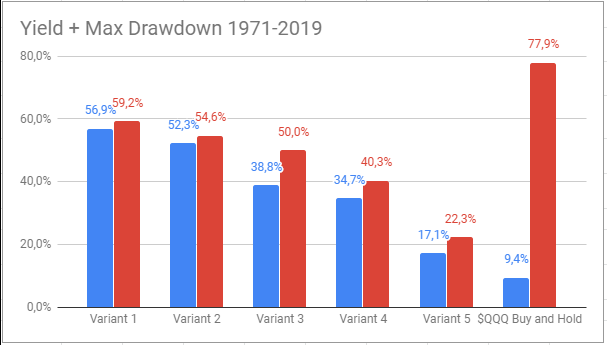Market has started a correction. Why don't we short it?
The HST model is actually Cash, due to recent instability of financial markets, especially on Tech companies.
Some members have been asking two specific questions, that I find interesting.
Here is the first:
"Since the market is dropping, and the HST model is not positioned Long anymore, why don't we short the market, trying to profit from this fall?"
We could short the market in several ways, for example buying inverse ETFs (which rise when markets fall), for example $PSQ is not-leveraged ETF for nasdaq, and $SQQQ is 3x leveraged ETF for Nasdaq.
We have considered this options in our backtests, using inverse ETFs when the model goes to "Cash" position.
[At the origin it was called "Cash-Short" position. We just mention the variants 2 and 5 of the HST model, but we've backtested five variants, and variant 1 and 3 were using $PSQ indeed.
Then we realized that 5 variants were somehow confusing for many followers, and we have decided to mention just the most popular: HSTv5 and HSTv2]
Please read here
https://hariseldontrader.joomla.com/index.php/tips-and-tricks-for-investors-blog-2/26-five-variants
Now, you see that buying an inverse ETF means to "short" the market, hoping it will fall.
You see that using $PSQ in "Cash-Short" periods (variant1 and variant 3), brings some additional gains (compared with variant 2 and variant 4), like ~4% more in CAGR (= average annual yield)
It also brings higher drawdowns.
We started backtesting the use of $SQQQ (3x leveraged inverse ETF) but drawdowns were totally unacceptable, reaching -82% in 2009, with no real benefits in the average yield. Option discarded!

Risk of bigger drawdowns is the reason why we do not short markets, nor use inverse ETFs.
Note that during markets' drops, daily moves are usually larger and choppy (-4% then +2%, then -5%...) like they were in Feb-Mar 2020 (see picture below). Volatility is higher, and so the risk ratio.
On the contrary, in bullish periods (see Q3 and Q4 of 2019), growth is more stable and slow.
Easy to see how the real money is made during bull periods, as Q3 and Q4 of 2019, or more recently Mar-Aug 2020.
Shorting markets during drops and crashes means to fight against the natural bias of markets, which is an amazing growth.
The following is a monthly chart of Nasdaq (on logaritmic scale). Do you wanna bet against this trend?
What if we are wrong, this correction is just a small pullback, and a bull period recomences in few days?
Conclusion:
As long-term investors we don't suggest shorting the US financial market, or we advise to keep small sizes, in case. It is a short term strategy, which requires a high competence in Technical Analysis, and intraday operations.
These are - of course - our personal opinions. We respect any choise made by other investors.
-----------------------------------
Write to This email address is being protected from spambots. You need JavaScript enabled to view it. and get more information about daily signals from the HST model released to members.
